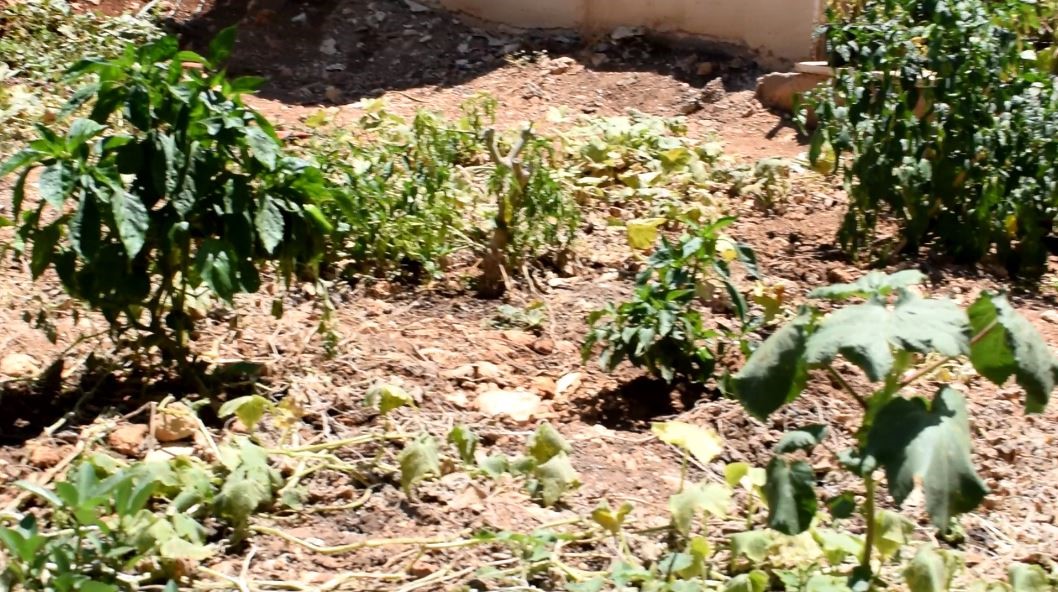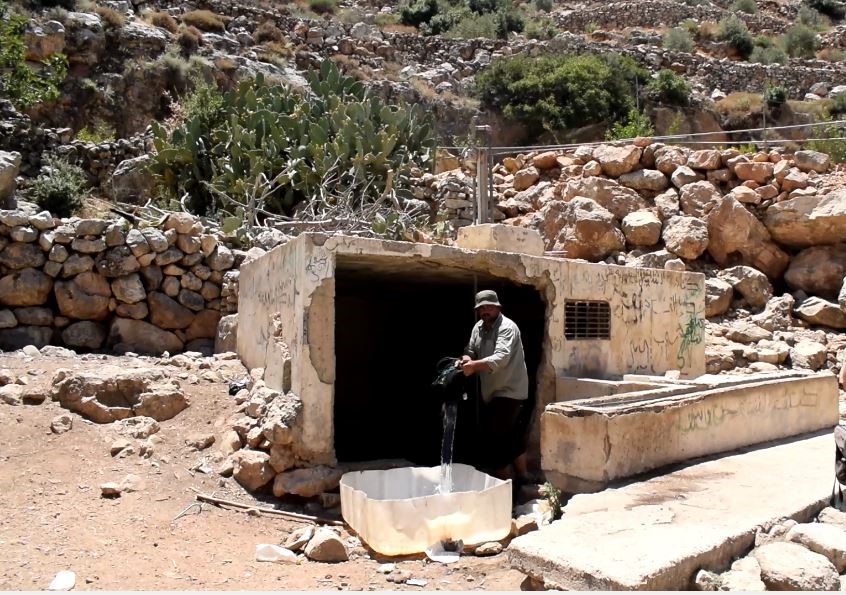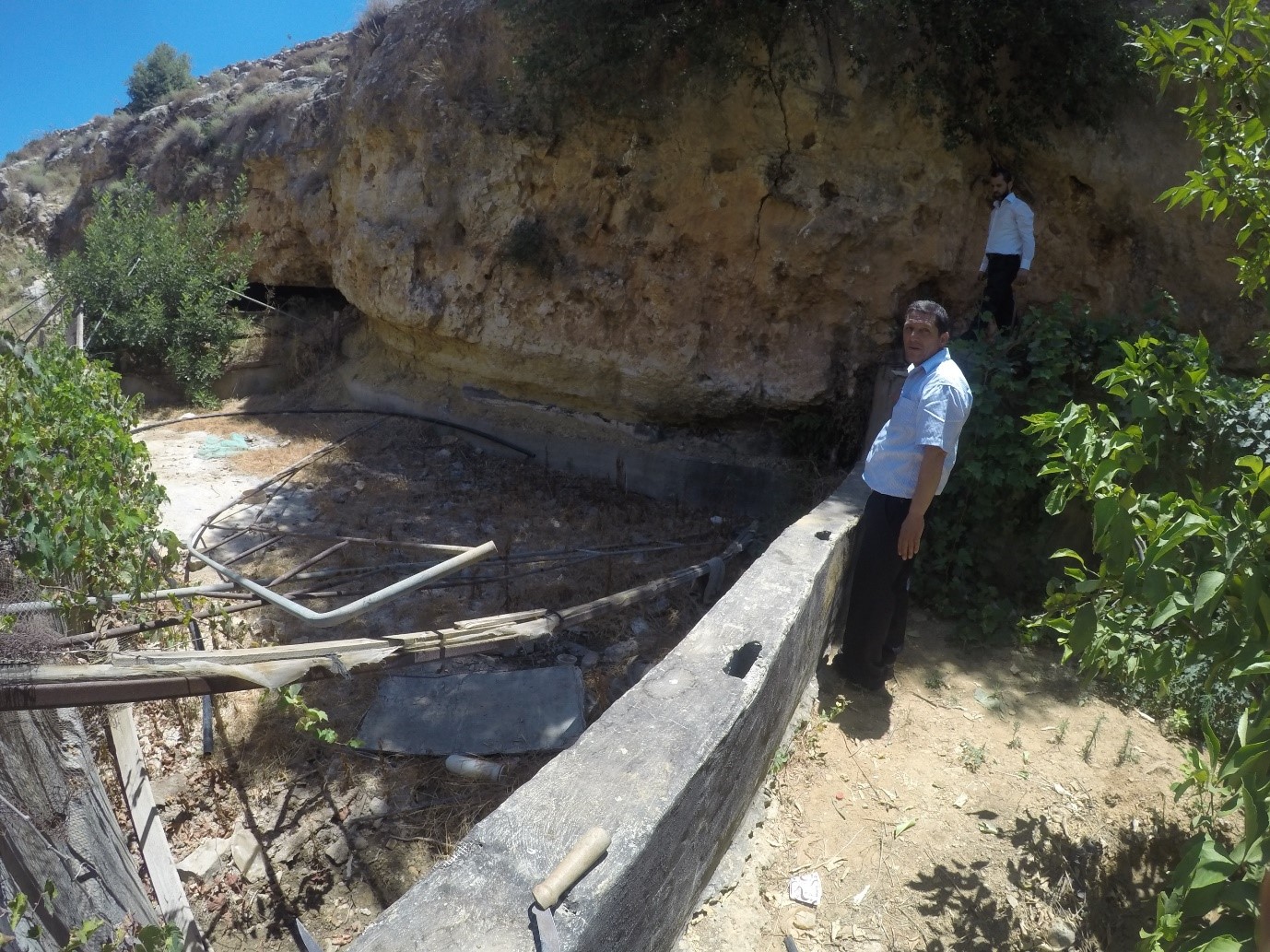Water Tour on the Ground with village chairman of Qarawat Bani Hasan
* The problem of water in Qarawat Bani Hasan is severest n the summer. Mekorot Israeli Water Company controls the main and at times lowers water pressure to such an extent that even the new pumps purchased by the village can hardly supply the water necessary in the village.
- The villagers fill their private wells and rooftop-tanks with water, but they pay for such water 10 times as much as the cost of water supplied through the Mekorot grid.
- The cattle and sheep/goat flocks are taken to a well 3 km from the village via a steep and dangerous track.
9:45 – we met Azeez Assi, head of the village of Qarawat Bani Hasan. We talked about the water problem which has received headlines lately because of the significant reduction in the quantity of water now received by the village. The situation is especially desperate now that the hottest season has begun.
Water comes to the village from Mekorot. The council pays this company 3 NIS per cubic meter, and the villagers purchase the water from the council at 3.5 NIS per cu.m. Three villages share this water: Qarawat Bani Hasan (population 6,000), Biddiya (12,000) and Sarta (4,000) – 22,000 persons total who receive about 30,000 cu.m. a month (calculated at 45 liters per person per day). The water is distributed to the villages according to their respective population size.
A tall water tank has lately been built, about 80 meters above the entrance road to the village, with the capacity of 500 cubic meters. Its construction was made possible by the donation of an organization abroad and money passed on by the village council. The tank is emptied swiftly especially in the summer. We could see the low level of the water, and that in the taps of certain houses in the village there was no water at all.
Problems began last year. Water pressure from Mekorot was not sufficient for the water to rise to the high tank. In order to solve this problem, the council purchased a pump costing 30,000 NIS. This year the situation has been exacerbated, and about two weeks ago an additional pump was installed, again costing 30,000 NIS. Azeez says, justly:
The pump helps only when there is water. If there is no water, no pumps can help. Now there is no pressure and no water in the tank. Another severe problem is that water cannot be supplied simultaneously to all three villages, because of that very problem of low pressure. Thus water reaches Biddya – the largest of the three – in daytime, and the two other villages at night.
How do they overcome the water shortage? In homes that have private water holes (about half of the houses), the owners fill them will water brought by tankers. In other homes, water is raised to the rooftop tanks with the help of pumps. This too costs. Water from the tankers costs 350 NIS per 10 cubic meter, 10 times more than the price of water by regular Mekorot supply.
We visited a villager who has sheep, fruit trees and a vegetable garden. At the entrance to his farm we saw barrels and jerry-cans filled with water that he pumps from a well 3 km from the village. When this is not possible he has to buy water from the tankers and pay 35 NIS a cubic meter. At his home we witnessed how little water comes out of the tap, sparsely and slowly.

We drove to Bir Abu Amer’s home, to see the village’s alternative water source. We drove about half an hour along Wadi Amer, along a steep track in breathtakingly beautiful landscape.The well that is 3-4 km from the village houses is an important water source and serves the villagers in times of need. They arrive on donkey back or in cars and carry water to the village in jerry-cans and other containers. We saw a local inhabitant pump water from the well in a bucket and transfer it to an improvised trough that was nothing but a large plastic container cut in half. Later he would bring his sheep here and water them. Near the well stands a taller trough filled with water. This is where the farmer we visited earlier would bring his goats if he has not enough water for them at home.

About 50 meters east of the well, inside a fruit tree grove and vegetable beds, is a cave under a large rock. A small ditch with spring water comes out of that cave. When we went in, the bottom was muddy and the spring weak. The ditch takes the water to a pool that, according to the owner, used to serve for growing fish. At the time there were also hothouses in the area. The army has destroyed both pool and hothouses and the debris is still visible.

the cave opening and spring
